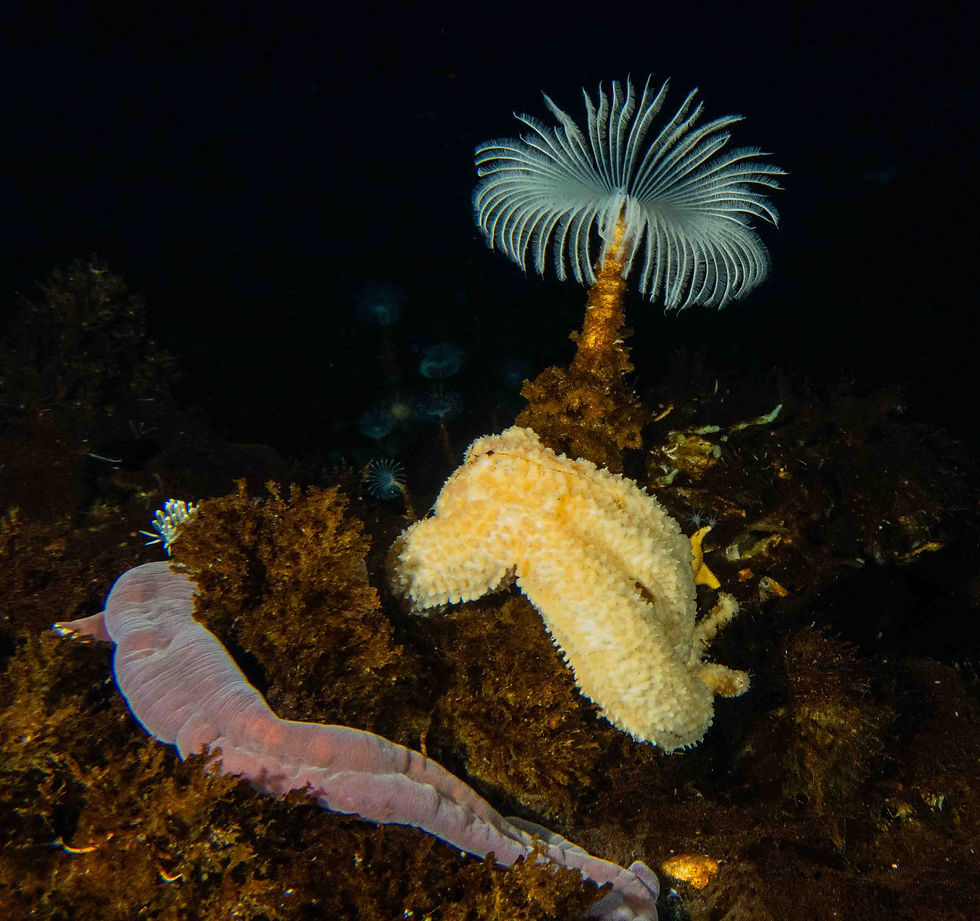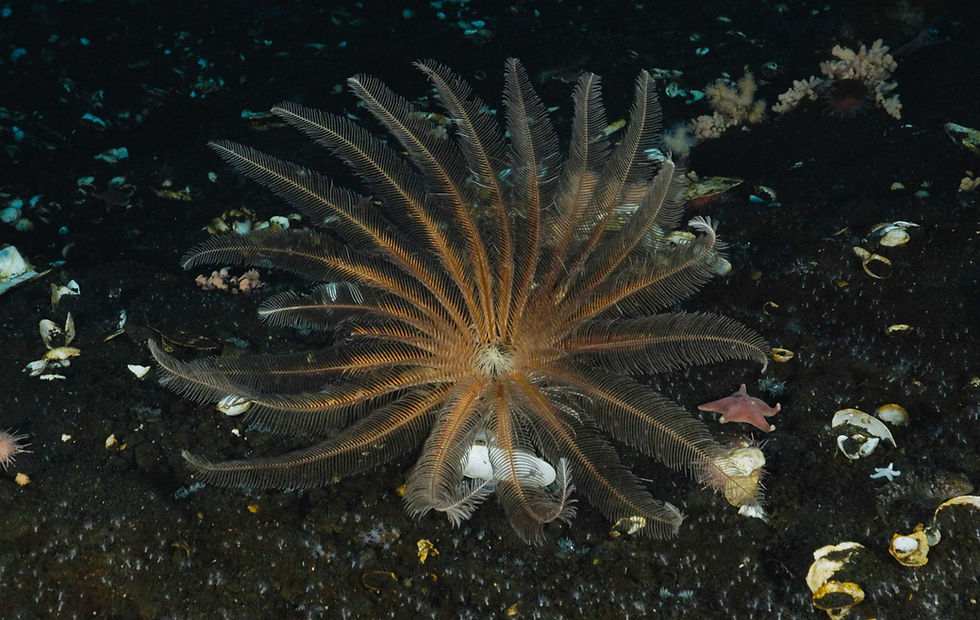Antarctic Marine Life - Part 1
- Rowan McLachlan
- Nov 12, 2023
- 5 min read
Today I wanted to share with you some of the photos I took during a dive at the Cinder Cones site on October 23rd and introduce you to some of the fantastic and bizarre animals we see down on the sea floor.

It was a beautiful day both above and below the ice. We park our Pisten Bully close to the dive hut door so that it is a shorter distance to carry all of our heavy gear!

Once inside, it is time to suit up! All the divers concentrate during this period of the day as we don't want to forget any of our gear. I have a checklist in my head that I run through every time I prepare to dive in Antarctica: don and zip-up dry suit, insert wrist tubes, attach dive computer, turn air on, don fins, ankle weights, weight belt, tank straps, attach dry suit inflator valve, check regs, turn on heated vest, defog mask, don gorilla hood, neoprene hood, latex hood, mask, glove liners, and finally dry gloves. When everything is set, it's time to jump!

Underwater, this dive site is topographically less diverse than our other sites, but it is the location of one of the important Antarctic methane seeps that we are researching.
Now to introduce you to some of the locals:
1) Sea Star Odontaster validus

This species of sea star lives throughout Antarctica at depths up to 915 meters! It grows to be about 7cm in diameter and takes ~9 years to reach the population average weight of 30g. It is estimated to live for up to 100 years! This sea star is near the top of the food chain in the Antarctic seafloor ecosystems and is a voracious predator akin to the lions of the Serengeti! It eats many things including, but not limited to detritus, small crustaceans, other sea star species, scallops, bryozoans, sponges, sea urchins, and worms.
2) Sea Star Acodontaster conspicuus

This species of sea star lives throughout Antarctica at depths up to 760 meters! It grows to be about 14cm in diameter. This species eats many species of sponges. They often aggregate and gang up on a single sponge, eventually killing it. The previous red species of sea star (Odontaster validus) gang up to feed on the Acodontaster species (as shown below in Norbert Wu's photo), and by doing so keep the population in check. Otherwise, this yellow species would get out of control and decimate the sponge populations.

3) Featherduster Worm (top), 4) Sea star Diplasterias brucei (yellow middle), and 5) Proboscis Worm (purple bottom left)

The featherduster worm (AKA: a sabellid polychaete worm) belongs to the genus Perkinsiana. It is found throughout Antarctica at depths ranging from 3 to 800m. It grows up to 20 cm long. It possesses a crown of feeding appendages (radioles) and uses these to filter seawater for food. They can be tricky to photograph because if you get too close or spook them, they retract their radioles down inside their protective tube which is made of calcium carbonate.
The sea star Diplasterias bruceii lives throughout Antarctica at depths up to 752m and grows to be about 24 cm in diameter. This is a specialized predator of molluscs including bivalves and gastropods.
Finally, the proboscis worm Parborlasia corrugatus lives throughout Antarctica at depths up to 3590m and grows to lengths of one to two meters, a diameter of two centimeters, and weighs up to 100g! Parborlasia corrugatus is a scavenger and a predator with a voracious appetite, and will eat almost anything; its diet includes sponges, jellyfish, diatoms, seastars, anemones, polychaete worms, molluscs, crustaceans, and fish. It can detect food at a distance with an efficient chemotactic sense. It has a large mouth and can consume prey almost as large as itself! Finally, they produce a lot of slime
6) Soft coral Alcyonium antarcticum

This species of soft coral lives throughout Antarctica at depths ranging from shallow to 642 meters. They live at least 4.5 years. It produces chemicals that it releases into the water that deter predators and bacterial growth. It uses its tentacles to capture and feed on plankton from the water. It is preyed upon by giant sea spiders.
7) Flabelligerid polychaete Flabegraviera mundata

Can you spot it? It really blends in with the brown sea floor. This species of worm is found throughout Antarctica at depths ranging from 6 to 850 m. Flabegraviera mundata grows up to 10cm long and 3cm wide. They feed on surface deposits, including sediment particles which they strip the nutrients from.
8) Soft-shelled Clam Laternula elliptica (white shells), 9) Nonothen Fish Trematomus bernacchii, and 10) Sea Urchin Sterechinus neumayeri (red)

In this photo, the red sea urchin has placed the shells of five dead clams on top of itself as camouflage, and the fish is resting upon the ensemble.
While the soft-shelled clams on top of the urchin in the photo are dead, there is actually a live clam shown in the photo too. At the bottom-middle of the image, you can see two black holes in the seafloor. These are the clam's siphons. Laternula elliptica is a filter feeder. It lies buried in the seafloor and extends two siphons to the surface. Water is drawn in through the inhalant siphon by a pumping action of the gills. As it passes over the gill flaps, gaseous exchange takes place, and food (phytoplankton and detritus) is captured and moved towards the mouth. The water then emerges through the exhalant siphon.
The fish, Trematomous bernacchii (AKA the emerald rock cod) is found throughout Antarctica at depths down to 700m. They grow up to 35cm in length. The females live up to 21 years and the males up to 16 years. It has a varied diet including, but not limited to: algae, crustaceans, nemerteans worms, hydroids, soft coral, jellyfish, anemones, sea urchins, bivalves, gastropods, fish, and fish eggs.

The sea urchin Sterechinus neumayeri lives throughout Antarctica up to depths of 640m. It is slow-growing, reaching a maximum diameter of 7cm at 40 years of age! Largely herbivorous, half of the diet of Sterechinus neumayeri is algae; it also eats diatoms, foraminiferans, sponges, bryozoans, hydrozoans, polychaete worms, and amphipods. They also enjoy feeding on seal poop 💩
The urchin Sterechinus neumayeri attaches bits of shell and debris to itself. The shells and debris often have stinging hydroids on them. If a predator (like the anemone Urticinopsis antarcticus) touches the urchin's hydroids, it releases the urchin. If the urchin is aware of the anemone's tentacles, the urchin will release its protective camouflage and escape the anemone's grasp. If this camouflage isn't present on the urchin, the anemone captures and eats the urchin.
11) Sea Spider Colossendeis megalonyx

Found throughout Antarctica at depths from 3 to 4900 m. They are often 20 to 30 cm in diameter! They feed on soft corals, small hydroids, sponges, and pelagic invertebrates, including the gastropod Clione antarctica, jellyfish, and ctenophores. Later in the dive, I found another one feeding on something gelatinous (as shown in the photo below). The giant Antarctic sea spiders might be my favourite animal here!




Comments